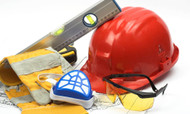5 Common Health Risks on Construction Sites
13th Mar 2023
Construction workers perform physically demanding work to build residential, commercial, institutional, and infrastructural projects. This high-hazard industry requires employers and employees to follow official safety rules and regulations. Discover five common health risks on construction sites and how to protect against them.
1. Struck-By Injuries
Construction sites have moving machinery and pieces of equipment that lift and swing objects around. Personnel working in areas near roadways also contend with passing civilian traffic. Equipment operators and pedestrian workers must stay vigilant around heavy machinery to avoid struck-by incidents, one of the leading causes of construction-related death.
High-visibility work clothes help reduce the risk of struck-by injuries. When workers wear hi-vis garments, other people can see them more easily. Construction workers should wear fluorescent hi-vis apparel for enhanced visibility in daylight with retroreflective material for low-light visibility.
2. Repetitive Vibration
Another common health risk on construction sites is repetitive vibration caused by power tools. Hand-Arm Vibration Syndrome (HAVS) is a common injury among construction workers. Symptoms of HAVS include tingling and numbness in the fingers, loss of hand strength, loss of finger sensation, and awakening at night with painful hands.
People can get HAVS from handheld power tools, ground working equipment, and vibrating power tools. Anti-vibration (A/V) tools reduce vibration characteristics found in conventional devices. Workers should also wear anti-vibration gloves to protect themselves from developing HAVS.
3. Auditory Damage
Repetitive and excessive noise can cause hearing impairment and even lead to deafness. Power tools and heavy-duty vehicles emit loud sounds that create a cacophonous work environment.
Employers must provide workers with adequate hearing personal protective equipment (PPE). Expandable foam plugs, canal caps, earmuffs, and pre-molded plugs are some types of PPE that can protect against auditory damage.
4. Slips, Trips, and Falls
Slips, trips, and falls are one of the leading causes of construction workplace injuries. Slick walking surfaces, sloped ground, poor lighting, clutter, improper scaffolding, unsafe stairs and ladders, and uncovered cables and wires can cause slips, trips, and falls.
As with other risks at construction sites, employers must conduct risk assessments to identify dangerous factors and determine whether current risk preventions are sufficient for everyone’s safety. Employees should be aware of risks and know how to operate around them. Everyone should keep walking channels clear of debris.
5. Manual Handling
Manually handling materials can lead to muscle and joint injuries. Incorrect positioning and form while lifting and carrying increases a person’s risk of injuries, such as lower back pain, or severe injuries like disc herniation.
Staff should use necessary equipment when possible to safely move heavy objects or to handle items repetitively. When workers must move things manually, employers must ensure everyone knows the proper physical form.
Improve your crew’s safety with custom hi-vis shirts from SafetyShirtz—your team will work more efficiently and securely in these stylish hi-vis clothes. Shop with us today for custom t-shirts and hoodies.

